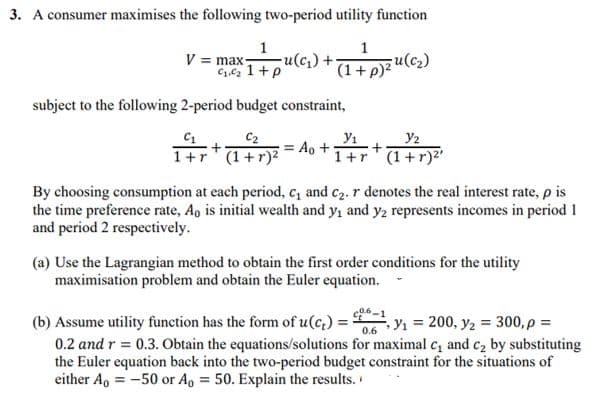A consumer maximises the following two-period utility function 1 u(c2) 1+p)² V = max- subject to the following 2-period budget constraint, C2 +r* (1+r)² Y2 = Ao ++r*(1+r)²' By choosing consumption at each period, c, and c2. r denotes the real interest rate, p is the time preference rate, A, is initial wealth and y, and y, represents incomes in period 1 and period 2 respectively. (a) Use the Lagrangian method to obtain the first order conditions for the utility maximisation problem and obtain the Euler equation. (b) Assume utility function has the form of u(c,) = 0.2 and r = 0.3. Obtain the equations/solutions for maximal c, and c2 by substituting the Euler equation back into the two-period budget constraint for the situations of either A, = -50 or A, = 50. Explain the results. = 200, yz = 300, p =
A consumer maximises the following two-period utility function 1 u(c2) 1+p)² V = max- subject to the following 2-period budget constraint, C2 +r* (1+r)² Y2 = Ao ++r*(1+r)²' By choosing consumption at each period, c, and c2. r denotes the real interest rate, p is the time preference rate, A, is initial wealth and y, and y, represents incomes in period 1 and period 2 respectively. (a) Use the Lagrangian method to obtain the first order conditions for the utility maximisation problem and obtain the Euler equation. (b) Assume utility function has the form of u(c,) = 0.2 and r = 0.3. Obtain the equations/solutions for maximal c, and c2 by substituting the Euler equation back into the two-period budget constraint for the situations of either A, = -50 or A, = 50. Explain the results. = 200, yz = 300, p =
Chapter17: Capital And Time
Section: Chapter Questions
Problem 17.1P
Related questions
Question

Transcribed Image Text:3. A consumer maximises the following two-period utility function
1
V = max
1
ule,) + Fu(c)
(1+p)?
subject to the following 2-period budget constraint,
C2
Ao +
1+r" (1+r)²
Y2
1+r*(1+r)²'
By choosing consumption at each period, c, and c2. r denotes the real interest rate, p is
the time preference rate, Ao is initial wealth and y, and y2 represents incomes in period 1
and period 2 respectively.
(a) Use the Lagrangian method to obtain the first order conditions for the utility
maximisation problem and obtain the Euler equation.
(b) Assume utility function has the form of u(c,) = 5
0.2 and r = 0.3. Obtain the equations/solutions for maximal c, and c2 by substituting
the Euler equation back into the two-period budget constraint for the situations of
either A, = -50 or Ao = 50. Explain the results.
, Y1 = 200, y2 = 300, p =
0.6
Expert Solution
This question has been solved!
Explore an expertly crafted, step-by-step solution for a thorough understanding of key concepts.
This is a popular solution!
Trending now
This is a popular solution!
Step by step
Solved in 3 steps

Knowledge Booster
Learn more about
Need a deep-dive on the concept behind this application? Look no further. Learn more about this topic, economics and related others by exploring similar questions and additional content below.Recommended textbooks for you

